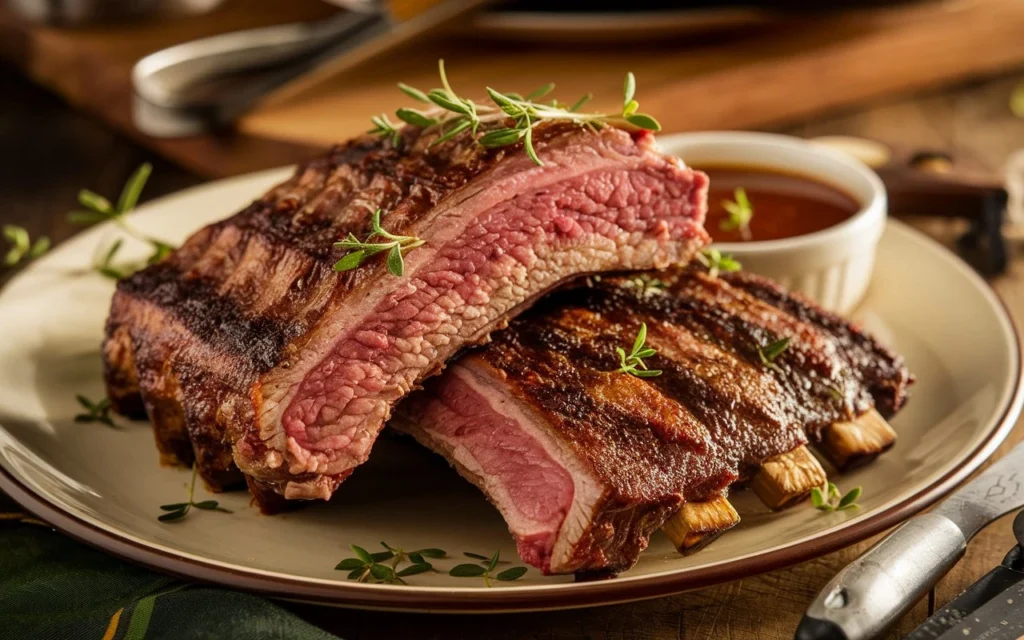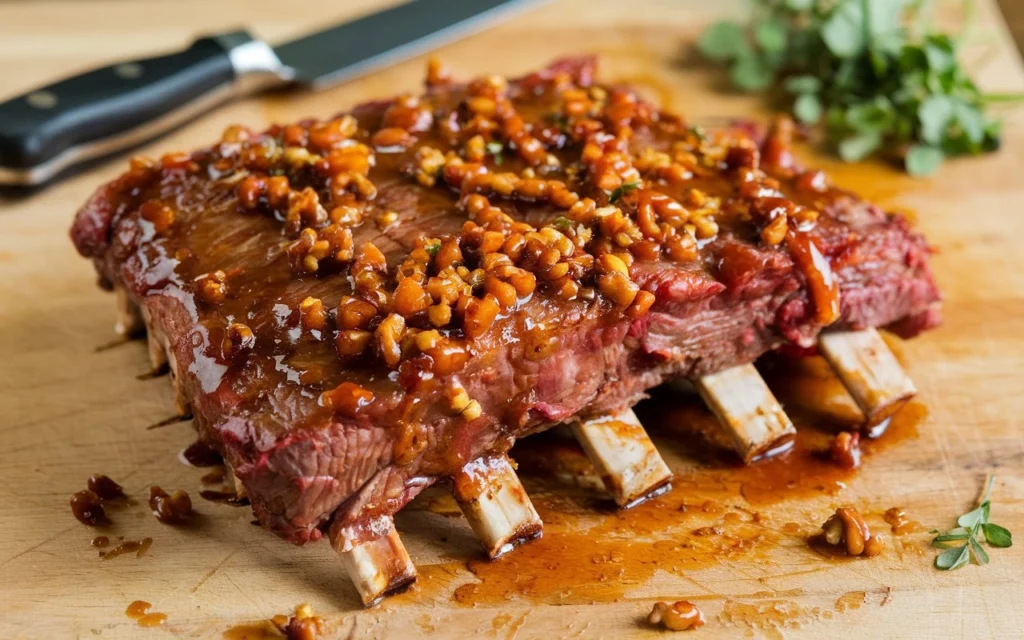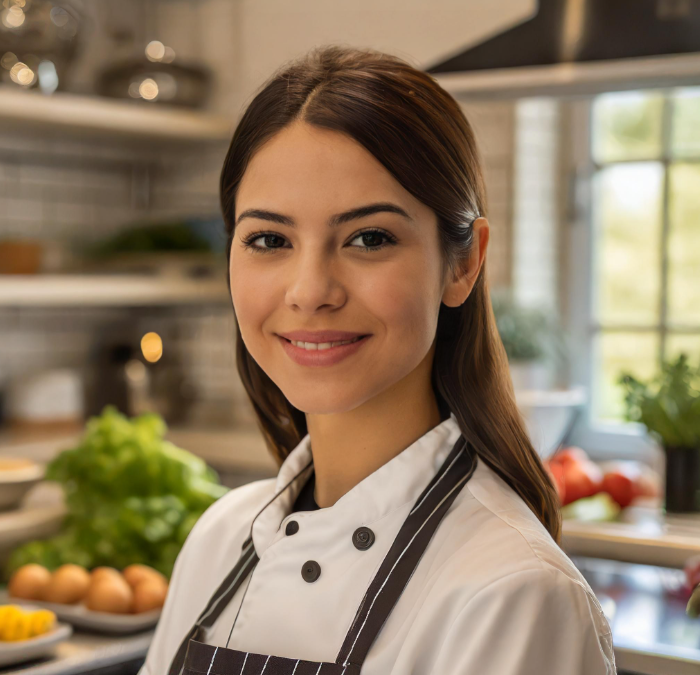Introduction
If you’ve ever dreamed of making perfectly tender beef ribs that fall off the bone with every bite, then you’re in for a treat. Cooking sous vide beef ribs is a game-changer for home chefs, BBQ enthusiasts, and anyone looking to master the art of precision cooking. The sous vide method guarantees consistent, mouthwatering results every time.
Unlike traditional cooking methods where ribs can dry out or become tough, sous vide allows you to cook them low and slow with water bath precision. This means you get juicy, flavorful ribs that are never overcooked. In this guide, we’ll walk you through every step — from selecting the best cut of beef ribs to seasoning, vacuum-sealing, cooking, and finishing them with a beautiful sear. By the end of this article, you’ll have all the knowledge you need to cook restaurant-quality ribs at home.
Introduction and Basics of Sous Vide Beef Ribs

What Are Sous Vide Beef Ribs?
Cooking sous vide beef ribs involves sealing the ribs in an airtight bag and cooking them in a temperature-controlled water bath. This modern cooking method, which translates to “under vacuum” in French, has taken the culinary world by storm due to its ability to cook food with precise control. Unlike grilling or oven-roasting, sous vide eliminates the risk of overcooking.
The result? Juicy beef ribs that are perfectly cooked from edge to edge, with no dry spots or raw centers. This technique gives you unbeatable tenderness, thanks to the consistent temperature maintained throughout the cooking process.
Why Sous Vide Beef Ribs Are a Must-Try
If you’re wondering why you should switch to cooking beef ribs sous vide instead of using a grill or smoker, here are some compelling reasons:
- Tender Every Time: No more chewy, tough ribs — sous vide ensures perfect texture.
- Flavor-Infused Ribs: Marinades and seasonings penetrate deep into the meat as it cooks.
- Set It and Forget It: Unlike grilling, there’s no need to babysit the ribs while they cook.
- Consistency Matters: Sous vide allows you to achieve restaurant-quality results at home.
With these benefits in mind, it’s no wonder sous vide cooking has become the go-to method for beef ribs.
The Science Behind Sous Vide Cooking
How Does Sous Vide Work?
Sous vide cooking uses a water bath to cook food at a precisely controlled temperature. Unlike conventional ovens or grills, where heat fluctuates, the temperature in a sous vide bath remains consistent. Here’s how it works:
- Sealing the Ribs: Beef ribs are vacuum-sealed in a bag to prevent water from seeping in.
- Precision Heating: The bagged ribs are placed in the water bath, where the temperature is set to the exact degree needed for the desired doneness.
- Low and Slow Cooking: The slow cooking process breaks down connective tissues, transforming tough ribs into melt-in-your-mouth goodness.
Why Precision Cooking Is Essential
Traditional cooking methods often rely on guesswork. One minute too long on the grill, and your ribs are dry. But with sous vide, every degree matters. For example:
- Cooking ribs at 135°F for 48 hours results in medium-rare, juicy ribs.
- Cooking at 165°F for 24 hours produces fall-off-the-bone tenderness.
Since temperature control is the secret to perfection, sous vide is the ultimate cooking hack for anyone craving consistent results.
What Makes Beef Ribs Perfect for Sous Vide?
Types of Beef Ribs for Sous Vide
Before you start cooking, you need to know which cut of beef ribs works best for sous vide. While you can cook any type of beef ribs using this method, some cuts produce better results than others.
- Short Ribs: The king of tenderness, short ribs are packed with marbling, giving them rich flavor and a melt-in-your-mouth texture.
- Back Ribs: These are leaner but have great flavor. Since they’re thinner, they require less cooking time.
- Plate Ribs: Thick and meaty, plate ribs are perfect for slow, long cooking. These are often preferred by BBQ lovers.
Which Cut Should You Choose?
If you want ribs with maximum tenderness and flavor, go for short ribs or plate ribs. Their higher fat content keeps them moist during long sous vide cooking times. Back ribs are a good option too, but they’re leaner, so be prepared for a slightly firmer texture.
Essential Tools for Cooking Sous Vide Beef Ribs
1. Immersion Circulator
This is the heart of sous vide cooking. The circulator maintains a precise temperature in the water bath, ensuring your ribs cook evenly. Look for features like adjustable temperature settings, Wi-Fi control, and durability.
2. Vacuum Sealer
A vacuum sealer removes air from the bag to create a tight seal around the ribs. This ensures no water leaks into the bag, keeping the seasoning intact. If you don’t have a vacuum sealer, you can use the water displacement method.
3. Sous Vide Container
A deep container holds the water and immersion circulator. Some people use large pots, but dedicated sous vide containers maintain heat more efficiently.
4. Meat Thermometer
While sous vide eliminates guesswork, it’s still a good idea to have a thermometer on hand to check the internal temperature before serving.
Preparation and Cooking Process
Preparing Beef Ribs for Sous Vide Cooking
How to Properly Trim Beef Ribs
Perfect sous vide beef ribs start with proper trimming. This crucial step ensures your ribs cook evenly and absorb all the delicious seasonings. Here’s how to do it:
- Remove the Silver Skin: This thin, shiny membrane on the underside of beef ribs doesn’t break down during cooking, leaving a chewy, unpleasant texture. Slide a small, sharp knife under the edge of the silver skin, then use your fingers to pull it off in one piece.
- Trim Excess Fat: While fat adds flavor, too much can result in greasy ribs. Trim off large chunks of exterior fat, but leave the marbling intact for flavor and moisture.
- Ensure an Even Thickness: Thick or uneven ribs cook inconsistently. If one side is much thicker than the other, trim it down to create a more uniform shape for even cooking.
Properly trimmed beef ribs not only look better but also cook more consistently, ensuring each bite is as tender and flavorful as the last.
Seasoning and Marinating Techniques
Dry Rubs vs. Wet Marinades: Which One Is Better for Sous Vide?
Seasoning is essential for making sous vide beef ribs as flavorful as possible. You have two main options:
- Dry Rubs: A blend of dry spices, herbs, and seasonings that coat the surface of the ribs. Dry rubs are ideal for creating a crust after searing. Popular spices for ribs include garlic powder, paprika, cumin, onion powder, and black pepper.
- Wet Marinades: Liquid-based blends that soak into the ribs. Marinades often contain ingredients like soy sauce, citrus, garlic, and Worcestershire sauce. Wet marinades penetrate the meat more deeply, enhancing flavor throughout.
Which Should You Choose?
For sous vide beef ribs, dry rubs are a top choice because they stick to the surface and contribute to a flavorful crust during searing. However, if you’re looking for bolder, deeper flavors, try marinating the ribs for several hours before vacuum-sealing them.
Marinating Time for Maximum Flavor Penetration
If you’re using a wet marinade, aim for 2 to 4 hours of marinating time. For maximum flavor, marinate overnight in the fridge. But remember, sous vide amplifies flavors, so you don’t need to go overboard with strong ingredients like garlic or onion powder.
Vacuum Sealing: Ensuring Optimal Results
The Role of Vacuum Sealing in Sous Vide Cooking
Vacuum sealing locks in moisture, flavor, and seasonings while keeping water out. Without it, water would seep into the bag, washing away all those delicious seasonings.
How to Vacuum Seal Beef Ribs for Perfect Cooking
- Use a Vacuum Sealer: Place the seasoned ribs in a sous vide bag, ensuring they’re laid flat in a single layer.
- Seal the Bag: Remove as much air as possible with a vacuum sealer. This prevents the bag from floating and guarantees even cooking.
- Check for Leaks: Inspect the bag for leaks, as air pockets can cause uneven cooking. If air remains, reseal the bag.
Alternatives to Vacuum Sealers
No vacuum sealer? No problem. Use the water displacement method:
- Place the ribs in a resealable plastic bag.
- Submerge the bag slowly into a pot of water, allowing the pressure to push out the air.
- Seal the bag tightly while it’s still underwater.
This method works in a pinch but may not be as airtight as a vacuum-sealed bag.
Setting the Ideal Temperature and Time
Best Temperature for Sous Vide Beef Ribs
The beauty of sous vide is that you control the tenderness of the ribs. Here’s a quick guide to temperature:
- 135°F (Medium-Rare): Juicy, steak-like ribs with some chew. Cook for 48 hours.
- 145°F (Medium): Tender, flavorful ribs that still hold their shape. Cook for 36 hours.
- 165°F (Fall-Off-The-Bone): BBQ-style tenderness where the meat pulls cleanly from the bone. Cook for 24 hours.
The higher the temperature, the faster collagen breaks down, leading to more tender meat.
How Long to Sous Vide Beef Ribs for Optimal Tenderness
Sous vide ribs are a lesson in patience. Cook them “low and slow” for the best results:
- 24 Hours: If you want ribs that pull right off the bone, cook them at 165°F for 24 hours.
- 48 Hours: For juicy, steak-like ribs, cook at 135°F for 48 hours.
The longer cooking time allows the connective tissues to dissolve, creating that fall-apart tenderness everyone loves.
The Impact of Temperature and Time on Taste and Texture
Time and temperature are the two key factors in sous vide cooking. Higher temperatures (like 165°F) create tender, “BBQ-style” ribs, while lower temperatures (like 135°F) produce a more “steak-like” texture. You can experiment with both to see which style you prefer.
Sous Vide Equipment Essentials
Must-Have Sous Vide Equipment
- Immersion Circulator: The most essential tool for sous vide cooking. It controls water temperature with precision, ensuring your ribs cook evenly.
- Vacuum Sealer: Seals food in an airtight bag, which is crucial for even cooking.
- Sous Vide Container: While you can use a large pot, dedicated sous vide containers maintain heat better and reduce water evaporation.
Tips for Buying a Quality Sous Vide Machine
- Temperature Accuracy: Look for a machine with precise temperature control (+/- 0.1°F).
- Easy Controls: Choose a machine with simple controls and Wi-Fi connectivity for convenience.
- Durability: Stainless steel circulators last longer than plastic ones.
Budget-Friendly Options for Beginners
For beginners, start with a lower-cost immersion circulator. Use a regular pot as your container and Ziploc bags with the water displacement method instead of a vacuum sealer.
Step-by-Step Guide to Cooking Sous Vide Beef Ribs
1: Prepare the Ribs
- Trim off silver skin and excess fat.
- Apply a dry rub or wet marinade.
2: Seal the Ribs
- Place the ribs in a vacuum-sealed bag or use the water displacement method.
- Check the seal for air bubbles.
3: Set the Temperature and Time
- Choose the temperature (135°F, 145°F, or 165°F) depending on your preferred texture.
- Place the bagged ribs into the sous vide water bath.
4: Cook the Ribs
- Cook the ribs for 24 to 48 hours, depending on temperature and desired tenderness.
- Longer cooking times produce more tender ribs.
Expert Tips, Storage, and Reheating

Pro Tips for Perfect Sous Vide Beef Ribs Every Time
Cooking sous vide beef ribs is easier than you think, but a few expert tips can take your ribs from good to legendary.
Avoid Common Mistakes
- Don’t Overcook: While sous vide allows for long cook times, leaving ribs in the water bath for too long (over 72 hours) can make them mushy.
- Don’t Under-Season: Sous vide intensifies flavors, so be sure to season generously. A dry rub or marinade with salt, garlic, paprika, and brown sugar works wonders.
- Pat Them Dry Before Searing: Wet ribs don’t sear properly. After sous vide cooking, pat them dry with paper towels before searing.
Experiment With Flavors
- Use Smoked Salt: Get a smoky BBQ flavor without a smoker by using smoked salt in your rub.
- Infuse with Garlic and Herbs: Add crushed garlic, rosemary, and thyme to the sous vide bag for a fresh herb-infused flavor.
- Finish with Flavored Oils: After searing, brush the ribs with truffle oil, chili oil, or garlic-infused olive oil for a flavor boost.
These pro tips can turn your ribs into a culinary masterpiece, full of rich flavor and perfect texture.
How to Store Sous Vide Beef Ribs
After all the effort of cooking sous vide beef ribs, you want to store them properly so you can enjoy leftovers.
Refrigeration
- Let the ribs cool to room temperature.
- Store in an airtight container or vacuum-sealed bag.
- Ribs can be refrigerated for up to 4 days without losing flavor or tenderness.
Freezing Sous Vide Beef Ribs
- Freeze leftover ribs by placing them in vacuum-sealed bags or airtight containers.
- They can last up to 6 months in the freezer.
- Label bags with the date and reheating instructions to avoid confusion.
Best Containers for Storage
- Vacuum Sealed Bags: Best for freezing and maintaining freshness.
- Airtight Plastic or Glass Containers: Work well for short-term refrigeration.
Proper storage keeps your beef ribs fresh, flavorful, and ready to enjoy later.
Reheating Sous Vide Beef Ribs Without Losing Flavor
Reheating ribs the right way can be tricky. Here’s how to do it without drying them out.
Best Methods for Reheating
- Sous Vide Reheat: Reheat ribs at 135°F for 1 hour to maintain juiciness.
- Oven Reheat: Place ribs in foil with a little broth or water to retain moisture. Bake at 275°F for 15-20 minutes.
- Stovetop Reheat: Add a small amount of water to a pan and cover with a lid. Heat on low for 10-15 minutes.
Avoid Microwaving
- Microwaves dry out ribs, making them tough and chewy.
- If you must microwave, wrap them in a damp paper towel to lock in moisture.
How to Keep Ribs Moist
- Brush ribs with BBQ sauce or beef broth before reheating to maintain moisture.
- Reheat them slowly at low temperatures to prevent them from drying out.
By following these storage and reheating tips, your sous vide beef ribs will taste just as fresh as the day you cooked them.
FAQs About Sous Vide Beef Ribs
What is the best cut of beef ribs for sous vide?
The best cut for sous vide beef ribs is short ribs or plate ribs due to their marbling and rich flavor. Back ribs also work, but they tend to be leaner and less tender.
How long should I sous vide beef ribs for the best results?
For tender, fall-off-the-bone ribs, cook them at 165°F for 24 hours. For steak-like texture, cook them at 135°F for 48 hours.
What temperature should I sous vide beef ribs at?
The temperature depends on your desired texture:
135°F for 48 hours (steak-like)
145°F for 36 hours (tender, but still firm)
165°F for 24 hours (fall-off-the-bone)
Can I marinate beef ribs before sous vide cooking?
Yes, you can marinate beef ribs before sous vide cooking. Let them marinate for 2-4 hours or overnight for maximum flavor. Since sous vide amplifies flavor, avoid strong marinades that may overpower the ribs.
How do I get a crispy crust on sous vide beef ribs?
After sous vide cooking, pat ribs dry with paper towels. Then, use a cast iron pan, broiler, grill, or kitchen torch to create a crispy crust. Sear for 1-2 minutes per side for a golden-brown finish.
Can I freeze sous vide beef ribs after cooking them?
Yes, you can freeze sous vide beef ribs. Store them in a vacuum-sealed bag or airtight container for up to 6 months. Thaw in the refrigerator overnight before reheating.
Conclusion
Cooking sous vide beef ribs is one of the most foolproof ways to guarantee juicy, tender, and flavorful ribs every time. From precise temperature control to long, slow cooking, this method eliminates the risk of overcooking and ensures you get perfect results. Unlike grilling or roasting, sous vide allows for complete control over doneness and texture, giving you fall-off-the-bone goodness every time.
With the right preparation, proper storage, and reheating techniques, you can enjoy your beef ribs fresh or as leftovers without losing any flavor. Vacuum-sealing, experimenting with flavor infusions, and mastering searing techniques all contribute to ribs that taste like they came straight from a 5-star restaurant.
Now, it’s your turn to try it out! Prepare your ribs, set the perfect temperature, and cook them to perfection. Once you’ve experienced how easy and delicious sous vide ribs are, you’ll never want to go back to traditional methods. Try it for yourself and share your sous vide success stories — you might even discover your own signature spice rub or marinade along the way.
Bon appétit!








